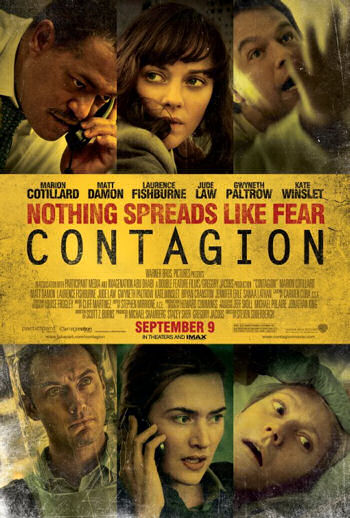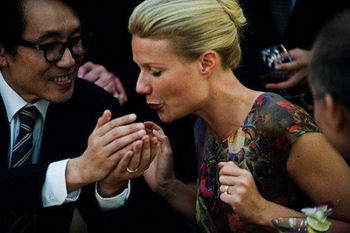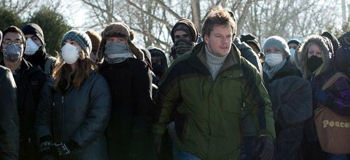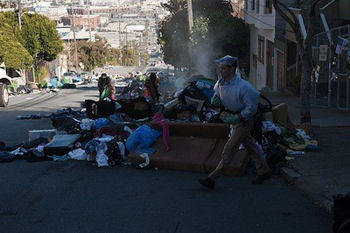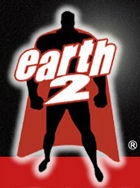|
Contagion
The smattering of first responses for Contagion from people who haven’t yet seen it have sounded like this, “Wasn’t this done already?” and then, “Wasn’t there already, like, an outbreak movie? Wait, wasn’t it called Outbreak?”
Yes, there was, but there are vast differences between that movie and director Steven Soderbergh’s smart and effective take on the pandemic genre. The common thread, though, is that humanity will always be susceptible to a global freakout when it comes to such a crisis, but the primary difference is the use of technology today.
Back in 1995, Wolfgang Peterson’s Outbreak came out with a blockbuster sheen, during a time when there was already a heightened awareness of Ebola and AIDS. It was also a year after Richard Preston’s best-selling non-fiction bio-thriller The Hot Zone was released. Speculative “What-if” scenarios were all over the media, feeding the flame of already growing fear.
Now, after the swine flu epidemic, West Nile deaths, and MRSA hysteria, Soderbergh stokes that flame and utilizes it to examine human behavior during such a threat. He also cleverly focuses on technology that didn’t exist during Outbreak. There were no cell phones that could take photographs or videos and post them online then, nor were they able to send text messages as quick as a finger snap. The word wide web itself was something entirely different then, and can now provide us with everything we know about airborne diseases.
Soderbergh observes all that daily tech use, just as he shows viewers what we may or may not already notice on a daily basis. We see the sneezes, the coughing, the hand shaking, as well as the touching of door handles, keyboards, and elevator buttons. As he follows the various government and medical organizations feverishly investigating this fictional disease, Soderbergh never allows viewers to lose sight of these everyday subconscious activities that are seen and heard countless times throughout the day.
That’s why the film starts out with coughing from Beth Emhoff (Gwyneth Paltrow), who is on a business trip in Hong Kong. She’s seen cavorting with clients at a restaurant, shaking hands and giving hugs, and then we see her fatigued and sniffling on a plane back to the States, looking like she hasn’t slept in a week.
We also see a server from that restaurant stricken with similar symptoms, and we know (because of the kind of movie we’re watching) that these are the first of many. Days after Beth arrives in Minnesota, both she and her son drop dead, leaving her husband, Mitch (Matt Damon) simply stunned.
The death of Beth isn’t a spoiler or a complete shocker. Even though Soderbergh has recruited a stellar line-up of talent with supporting work from the likes of: John Hawkes, Bryan Cranston, Sanaa Latham, Elliot Gould, and Demetri Martin (proving that Soderbergh is indeed still a draw for actors), it’s obvious we shouldn’t expect all of them to live. After all, Soderbergh is clearly crafting this as The Towering Inferno of the pandemic genre.
Unlike those Irwin Allen disaster movies, there’s no grandiose music swell or motivational speech from a self-appointed leader here. Instead, the focus and overall tone of the film is a what-would-happen-in-real-life simulation.
Because Soderbergh and screenwriter Scott Z. Burns (reuniting after The Informant!) have chosen a global response viewpoint to this crisis, never settling to follow the plight of one individual or group, there’s not time for everyman-heroism.
We see such characters hunker down in their homes, to protect and survive. That’s what Mitch does with his teen daughter. For some reason, he’s immune to the fatal disease and so far, so is she. But, if you think it’s easy to keep a teen girl in lock-down mode, with access to internet, TV, and the never-ending texting with the boyfriend, well, you haven’t been around teens lately.
When we’re not with Damon’s character (who basically serves as you, the viewer), Soderbergh and composer Cliff Martinez sends us bouncing and shuffling through a variety of researchers and decision-makers. Chief among them is Dr. Ellis Cheever (Laurence Fishburne) of the CDC (Center for Disease Control), who has Dr. Erin Mears (Kate Winslet), an epidemiologist who hits the ground running, serving as Cheever’s eyes and ears. This could’ve been a throwaway role, but because it’s Winslet, we’re treated to an actual character here, with quirks and nuances.
While Mears is investigating stateside, another epidemiologist, Dr. Lenora Orantes (Marion Cotillard), working for theWHO (World Health Organization), is in Hong Kong, at the alleged origin of the outbreak.
Like Winslet, Cotillard brings more to the character than what time allows. What happens to her is frightening yet what we see her discover is heartbreaking. In a film littered with admirable talent, these two Oscar winners are natural standouts.
Midway through the film, a cure is found by Dr. Ally Hextail (Jennifer Ehle), a dedicated scientist in the States. The way she discovers it and how she tests it provides impressive development to her character. Ehle delivers some surprisingly captivating work with such unassuming ease. She easily became one of my favorite characters to follow.
When news of a cure spreads, so does the craziness. Everyone wants it, but how much is available and who gets priority? Soderbergh cranks up the tension in these scenes as he shines a bright light on our basic instincts. As the onslaught of viral videos, talking heads, and impassioned bloggers spread, the hysteria inevitably increases. This brings out the requisite ugliness of humanity (aka looting and brawling) as well as the loons.
One arrogant and self-capitalizing loon is San Francisco blogger Alan Krumweide (Jude Law), who comes across like a truth-seeking voice of the people when all he’s doing is building the panic while accruing funds from online followers.
The inclusion of Law’s character is understandable, but it feels like too much time is given to him. In the third quarter of the film, Law can be seen walking around the desolate and abandoned streets of San Francisco in what looks like a protective bubble suit from a Disaster Relief convention. These scenes invoke a “Last Man on Earth” vibe that feels somewhat off from the rest of the film.
There’s been enough panic in the real world since Outbreak to draw from, making this film one that will leave you unsettled with any close encounter. An auteur like Soderbergh knows that making a bowl of peanuts at a bar seem letha, is the best way to give viewers the utmost uneasiness.
It’s an appropriate and palpable feeling needed for such a film and definitely made me think twice about what or who I come into contact with. Indeed, everyone will want to pack extra hand sanitizer after watching this thriller, and maybe even consider going vegetarian
(This
review also appears on David's own website,
Keeping It Reel.)
|
